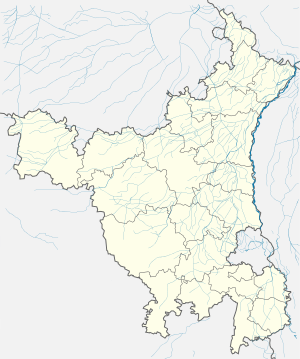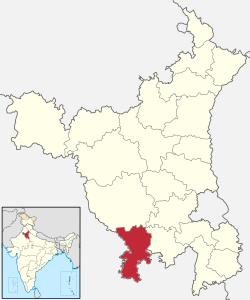Nangal Sirohi
| Nangal Sirohi नांगल सिरोही | |
|---|---|
| city | |
 Nangal Sirohi Location in Haryana, India  Nangal Sirohi Nangal Sirohi (India) | |
| Coordinates: 28°11′35″N 76°07′55″E / 28.193161°N 76.132078°ECoordinates: 28°11′35″N 76°07′55″E / 28.193161°N 76.132078°E | |
| Country |
|
| State | Haryana |
| District | Mahendragarh |
| Area | |
| • Total | 10.4 km2 (4.0 sq mi) |
| Population (2001) | |
| • Total | 10,000 |
| • Density | 960/km2 (2,500/sq mi) |
| Languages | |
| • Official | Hindi |
| Time zone | UTC+5:30 (IST) |
| PIN | 123028 |
| Telephone code | 01285 |
| ISO 3166 code | IN-HR |
| Vehicle registration | HR-34 |
| Website |
haryana |
Nangal Sirohi, famous for the painted shekhavati rajput architecture havelis, is a town in Mahendragarh district in the Indian state of Haryana.[1] It is 9 km from Mahendragarh towards Narnaul (16 km from Narnaul) in South Haryana.
History
Nangal-Sirohi was founded by Yaduvanshi Ahirs of Khosya gotra whose ancestors came from the neighbouring Deroli village. 400 years ago, Sirohi was owned by Gujjars of rebellious streak who did not pay revenue to then Mughal Nazim at Narnaul, they escaped to the forests when mughals came to collect revenue. Consequently, Mughals offered this area to Dropaal, a Gujjar from nearby Daroli village, who became the chaudhary of this estate responsible for collecting the revenue.[1]
Havelis and architecture
This area which was earlier under the Jaipur state, came under the Sindhu Jat ruler Maharaja of Patiala.[1] Lala Tek Chand was first among them to build the fortalice haveli.[1] Nangal Sirohi, 9 km from Narunail and 16 km from Mahindragarh, is famous for its historic havelis built by baniyas who had migrated from Satnali 8 generations ago (c. 2002).[1] Later in Vikram Samvat 1959 (1902 CE), Lala Deen Dayal built an ornately decorated caravanserai in Shekhavati Rajput architecture.[1]
Havelis are located in the older Part of the village called Oopla Baas (upper residence), built by local trading communities in 18th and 19th century. These were built by Chejaraas (masons) and Chiteyraas (painters) summoned from Shekhawati region of the erstwhile Jaipur State of Rajpootana, who painted the images of Shekhawati Sirdars and events from the native feudal life. In one of the haveli there are paintings depicting Shekhawati Sirdaars, while in the vault of the other haveli there are scenes from the Ramayana and Hindu gods. The color pigments in the wall paintings of the later haveli vault have been remarkably preserved for more than 100 years now and look fresh.[1]
Several of these havelis are facing neglect due to migration of their owners to other areas for the business. Havelis are of artistic excellence, academic and cultural significance, there is lack of awareness about their conservation or documentation by scholars.[1]
Population
A village of soldiers and businessmen, it has 500 families of Ahirs, 100 families of Baniyas, 80 families of Brahmins, 20 families of Kumhars (potters), 10 families of weavers, 10 families of barbers, 35 families of masons and carpenters, 2 families of Darzi (Chhipi) and, families of Jogis.[1] Founder of Modi Group of Industries came from here.
